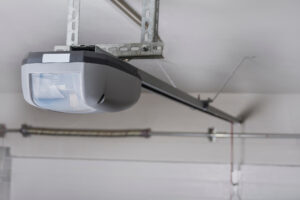
Garage door provisions in the International Residential Code
A key aspect of safety for garage door systems is recognizing the importance of code compliance
Why garage doors matter
Garage doors are generally the largest product in a single-family home — and with automatic openers — are very complicated assemblies. Remodeling Magazine ranks garage door replacement as one of the highest-value remodeling projects in its annual surveys, due to the impact on curb appeal. Garage doors provide access for vehicles, but also help open up homes to the outdoors. With the safety of the installed assembly first and foremost, the industry has seen numerous innovations that improve the performance of these access systems while reducing the potential for injury to building occupants.
 That is why each year the door and access systems industry recognizes Garage Door Safety Month. While the industry stresses safety year-round, May is a special month for the International Door Association and the Door & Access Systems Manufacturers Association to share their dedication to safety with their member partners and with a broad audience of architects, building inspectors, specifiers and general contractors. Both organizations are also collaborating with the International Code Council to include as part of the Code Council’s Building Safety Month, also observed each May.
That is why each year the door and access systems industry recognizes Garage Door Safety Month. While the industry stresses safety year-round, May is a special month for the International Door Association and the Door & Access Systems Manufacturers Association to share their dedication to safety with their member partners and with a broad audience of architects, building inspectors, specifiers and general contractors. Both organizations are also collaborating with the International Code Council to include as part of the Code Council’s Building Safety Month, also observed each May.
Another key aspect of safety for garage door systems is recognizing the importance of code compliance. The U.S. Consumer Product Safety Commission has worked with UL (Underwriters’ Laboratories) on the standards for garage door openers to help reduce the likelihood of injury from entrapment by a garage door assembly. The Federal Emergency Management Agency (FEMA) has also included garage door performance in its post-disaster Mitigation Assessment Team (MAT) reports providing guidance to public and private stakeholders interested in improving building performance from natural disasters such as tropical storms and hurricanes. The FEMA MAT reports cover as far back as Hurricane Andrew in 1992, and more recent storms like Hurricane Irma and Hurricane Michael have noted the opportunity to help maintain the structural integrity of the building by reducing the chance of garage door damage due to high wind events. The FEMA MAT report cited garage door damage as a key contributor to cascading pressurization of the building that led to a blow-off of the roof assembly.
Whether addressing the need for listed garage door openers or meeting the wind load requirements, compliance with the International Residential Code (IRC) is an important piece of the puzzle.
International Residential Code provisions
The 2021 IRC includes provisions for garage doors that cover permitting, labeling for wind load resistance, garage door opener listing and other general provisions. Section R105.1 of the 2021 IRC includes repairs and alterations as activities requiring a building permit. Subsequent text in Section R105.2 lists the construction activities that are exempt from the permitting requirements; garage door replacement is not on that list. Section R105.2 also states that exemption from permitting is not an exemption from the requirements in the code, so in cases where local jurisdictions waive permitting requirements for garage door replacement, the technical provisions in the IRC stand.

Automatic garage door openers are subject to provisions in Section R309.4 that require the openers to be listed and labeled to UL 325. The standard includes a variety of required features that address the safe use of the opener as well as release mechanisms that will disengage the opener to permit the operation of the door during a loss of electrical power. One of the key safety provisions in UL 325 is the inclusion of a mechanism to identify obstructions in the opening (most often through the use of photoelectric sensors) and to reverse the door closing should the door meet an obstruction.
Two code change proposals (RB207-22 and RB86-22) — to add requirements that the installation of garage doors and openers should be in accordance with the manufacturer’s installation instructions — were recommended for approval by the IRC Code Development Committee in Rochester, New York, last month. The process is still ongoing, and if the proposals are ultimately approved by International Code Council membership they will be included in the 2024 IRC.
The 2021 IRC also includes a new labeling requirement for wind load labeling in Section R609.4.1:
R609.4 Garage doors. Garage doors shall be tested in accordance with either ASTM E330 or ANSI/DASMA 108, and shall meet the pass/fail criteria of ANSI/DASMA 108.
R609.4.1 Garage door labeling. Garage doors shall be labeled with a permanent label provided by the garage door manufacturer. The label shall identify the garage door manufacturer, the garage door model/series number, the positive and negative design wind pressure rating, the installation instruction drawing reference number, and the applicable test standard.
It should be noted that the wind load provisions for all exterior doors, windows and skylights have been part of the IRC since 2000. This new provision establishes the need to include a label on each garage door and requires the label to list the positive and negative design load pressure ratings.
What to look for
Code officials and building inspectors should be looking for design pressure requirements for their jurisdiction. For new construction, design pressures are part of the design package, but for garage door replacement it is helpful to understand the typical design pressure requirements. Design pressures are based on several factors, including wind speed, building height, occupancy, exposure category and even the position of the door within a wall assembly.
The design pressure rating should be listed on all garage doors — new and replacements. Building inspectors should check the door to ensure the label is present and that the design pressure ratings meet or exceed the requirements in their area.
Industry resources
For jurisdictions that haven’t focused on garage door compliance, developing a program to include doors and openers in plan review and inspection procedures might be a daunting task. The good news is that the Door & Access Systems Manufacturers Association has published a variety of resources in its Technical Data Sheet library. These publications cover topics like how to calculate design pressure ratings, jamb attachment details and inspection checklists. The Technical Data Sheet library can be accessed at: https://www.dasma.com/technical-data-sheets/
The International Door Association is available to assist local departments with questions on product installation and performance concerns and for information about available educational resources. You can reach them by email at info@doors.org.








